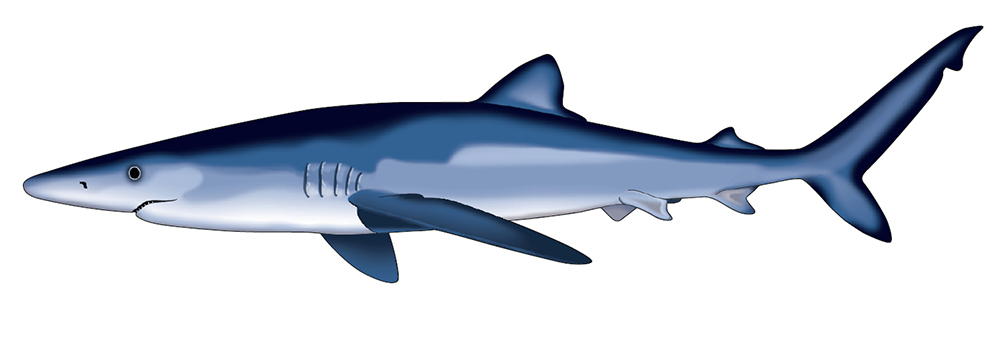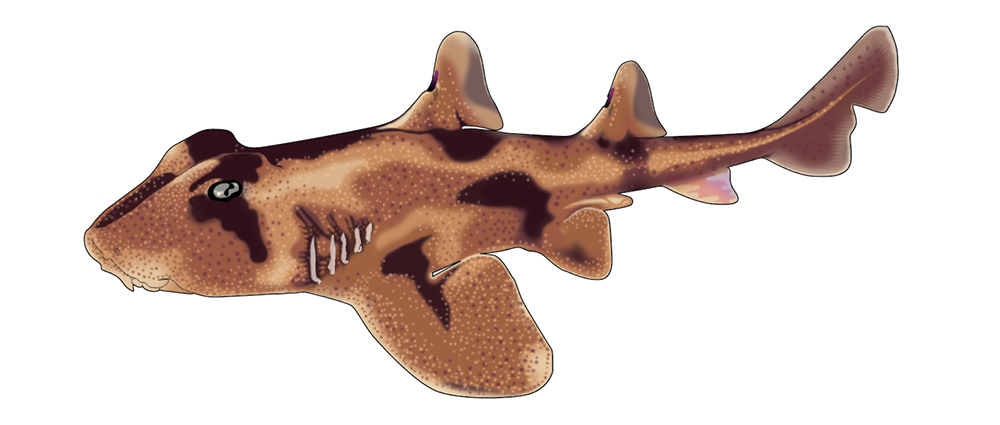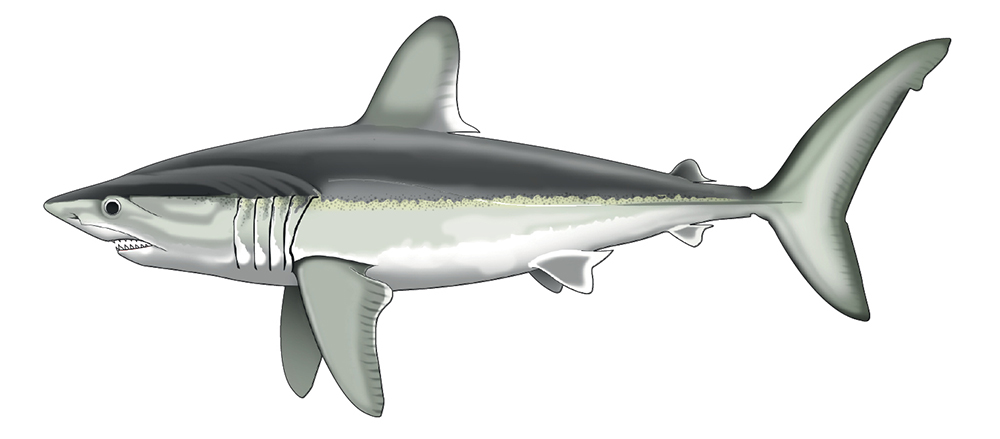Shark Guide
The world’s oceans are home to eight identified orders of sharks, with thirty-one families that include a total of about 479 shark species. As ichthyologists discover previously unknown species, the number of species changes. Biological classification of sharks also evolves as researchers gain a new and better understanding of shark morphology (body shape) and genetics (underlying species relationships). This Shark Guide lists the eight orders with one example species for each. To learn more about other sharks within each order, go to the Encyclopedia of Life (www.eol.org) or SharkSider (www.sharksider.com).
The IUCN Red List is the gold standard of conservation status. The organization ranks an animal’s status in order of seven risk levels of extinction: Least Concern, Near Threatened, Vulnerable, Endangered, Critically Endangered, Extinct in the Wild, or Extinct. The IUCN labels some species as Data Deficient because scientists don’t yet have enough information about the animals to make a determination. Other species may be listed as Not Evaluated if the animals have not been studied yet. The rankings in this Shark Guide are from the IUCN Red List. (If you are wondering whether there’s more room for shark scientists, the answer is yes!)
Carcharhiniformes
These ground sharks include 270 species, such as hammerheads, catsharks, blue, tiger, lemon, and whitetip sharks. Scyliorhinidae (catsharks) are one of the largest families of this type of shark, with about 160 species. Ground sharks all have nictitating eyelids, a mouth positioned behind the front of their eyes, five pairs of gill slits, an anal fin, and two spineless dorsal fins.
| Blue Shark |
|
| Scientific name |
Prionace glauca |
| Habitat |
found in all the world’s oceans, from the surface to waters 1,150 feet (350 m) deep |
| Length |
maximum recorded size up to 13 feet (4 m) |
| Weight |
up to 450 pounds (204 kg) |
| Diet |
small bony fish and invertebrates, such as squid; also dead mammals |
| Features |
named for the shark’s vivid blue color |
| Status |
Near Threatened |

Heterodontiformes
The 9 species of bullheaded, or horn, sharks are found in the Indian and Pacific Oceans. Bullheaded sharks all have a piggish snout, a sharp eyebrow-like ridge above the eye, a small mouth well forward of their eyes, spined dorsal fins, and an anal fin.
| Crested Bullhead Shark |
|
| Scientific name |
Heterodontus galeatus |
| Habitat |
bottom-dwelling, living off the coast of eastern Australia |
| Length |
maximum recorded size of 3.9 feet (1.2 m) |
| Weight |
undocumented |
| Diet |
mollusks, sea urchins, and small bony fish |
| Features |
slow moving, lurk in undersea caves, and feed at night |
| Status |
Least Concern |

Hexanchiformes
The frilled and cow sharks include six- and seven-gill sharks such as the broadnose sevengill and the bluntnose six-gill. Hexanchidae (cow sharks) include 37 species. Hexanchiformes, considered the most primitive sharks, all have six or seven pairs of gill slits, one dorsal fin (set low on their backs), one anal fin, a low caudal fin, and large, teardrop-shaped eyes.
| Sharpnose Sevengill |
|
| Scientific name |
Heptranchias perlo |
| Habitat |
deep waters almost everywhere except the northern Pacific Ocean |
| Length |
maximum recorded size of 4.6 feet (1.4 m) |
| Weight |
maximum weight of 236 pounds (107 kg) |
| Diet |
small bony fish, shellfish, invertebrates such as mollusks, and small sharks and rays |
| Features |
green eyes and jagged upper teeth to grip thrashing prey |
| Status |
Near Threatened |

Lamniformes
The mackerel sharks are a varied group of big and big-mouthed sharks that includes basking, great white, shortfin mako, thresher, sand tiger, goblin, and megamouth sharks. The 15 species comprise a fraction of the hundreds of lamniformes that have come and gone. The family Odontospididae (sand tiger sharks) has 4 species. Mackerel sharks have no nictitating eyelids, a mouth positioned behind the front of their eyes, five pairs of gill slits, an anal fin, and two spineless dorsal fins.
| Porbeagle |
|
| Scientific name |
Lamna nasus |
| Habitat |
found mostly in the 30°N to 70°N and 30°S to 50°S latitudes in all oceans |
| Length |
12 feet (3.5 m) |
| Weight |
298 pounds (135 kg) |
| Diet |
cephalopods (squid and octopus) and bony fish |
| Features |
known by the white spot at the base of the dorsal fin |
| Status |
Vulnerable |

Orectolobiformes
The carpet sharks are a diverse group of 39 species of sharks. They include whale, nurse, zebra, bamboo, and wobbegong sharks. Carpet sharks all have a mouth completely in front of their eyes, two spineless dorsal fins, an anal fin, and five pairs of gill slits. Except for the whale shark, they are all bottom-dwellers and have a spiracle below each eye to help with breathing. The whale shark’s spiracles are to the rear of each eye. Most carpet sharks live in the Indian Ocean or the western Pacific Ocean. Whale sharks live in tropical and warm temperate waters worldwide.
| Nurse Shark |
|
| Scientific name |
Ginglymostoma cirratum |
| Habitat |
subtropical and tropical Atlantic and Pacific Oceans |
| Length |
maximum recorded size of 10 feet (3 m) |
| Weight |
up to 330 pounds (150 kg) |
| Diet |
little fish, snails and other mollusks, and crustaceans |
| Features |
makes sucking sounds while hunting in the sand |
| Status |
Data Deficient |

Pristiophoriformes
The saw sharks comprise 8 species. They all have a saw—a flattened, bladelike snout edged in teeth. Saw sharks have spiracles for breathing, dorsal fins without spines, nasal barbels, and five or six pairs of gill slits. They have no anal fin.
| Common Saw shark |
|
| Scientific name |
Pristiophorus cirratus |
| Habitat |
the underwater continental shelf along the coast of southern Australia |
| Length |
maximum size of 5 feet (1.5 m) |
| Weight |
19 pounds (8.6 kg) |
| Diet |
fish, squid, and crustaceans |
| Features |
bottom-dwellers with extra-long nasal barbels the shape of mustaches for sensing buried prey |
| Status |
Least Concern |

Squaliformes
The dogfish sharks live mostly at the bottom of the deep sea. They are the second-largest order of sharks, with 119 species. The family Squalidae, the spiny dogfish sharks, live in shallower waters. Dogfish sharks all have a spine along the forward edge of their dorsal fins, large almond-shaped eyes, and a large spiracle behind each eye. Many dogfish are bioluminescent, producing their own light.
| Spiny Dogfish |
|
| Scientific name |
Squalus acanthias |
| Habitat |
along the coasts of Europe, the United States, Canada, New Zealand, and Chile diving as deep as 2,900 feet (884 m) in winter |
| Length |
up to 49 inches, or 124 cm (females), and 39 inches, or 99 cm (males) |
| Weight |
females from 7.1 to 9.9 pounds (3.2 to 4.5 kg); smaller and lighter males |
| Diet |
schooling fish such as herring and capelin as well as jellyfish and squid |
| Features |
the longest pregnancy of any vertebrate, twenty-two to twenty-four months |
| Status |
Vulnerable |

Squatiniformes
The 19 species of angel sharks include the family Somniosidae, the “sleeping sharks.” Angel sharks have flattened bodies, large front heads with skin flaps, raylike mouths, nasal barbels, and no anal fin.
| Greenland Shark |
|
| Scientific name |
Somniosus microcephalus |
| Habitat |
North Atlantic and Arctic Oceans |
| Length |
maximum recorded size of 21 feet (6.4 m) |
| Weight |
up to 3,100 pounds (1,406 kg) |
| Diet |
voracious appetite; eels, fish, other sharks, and carrion (dead animals), even moose and reindeer remains discovered in their stomach |
| Features |
the longest life span of all vertebrate species, up to 500 years or more and takes 150 years to reach sexual maturity; Greenland shark flesh, nontoxic when dried but poisonous when fresh |
| Status |
Near Threatened |
